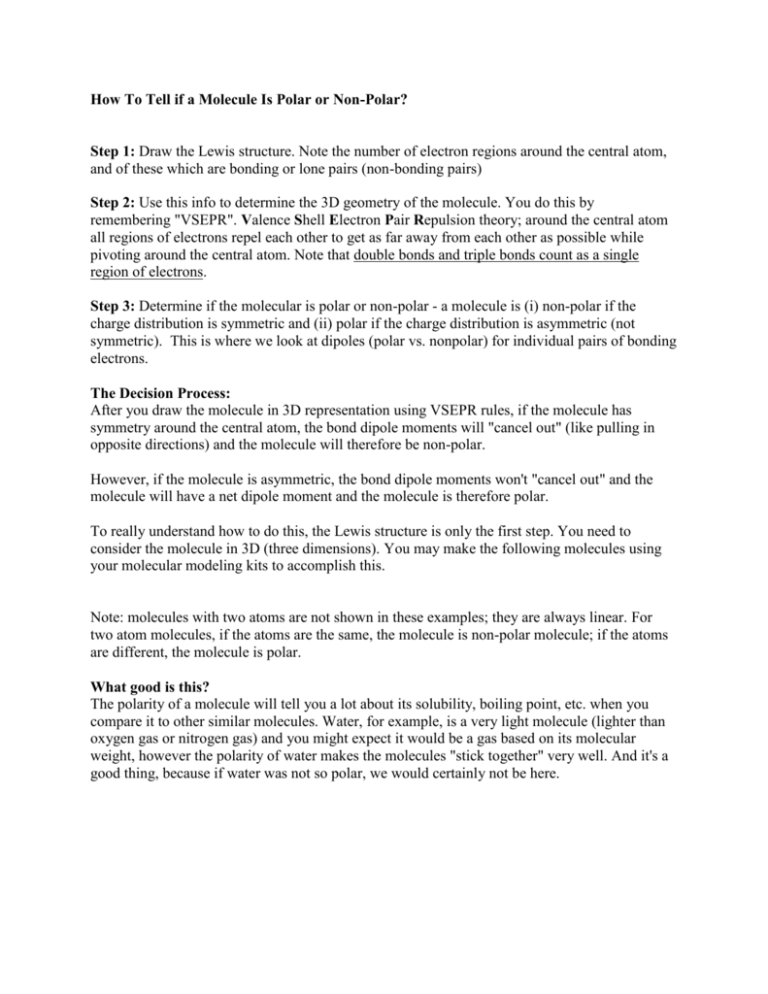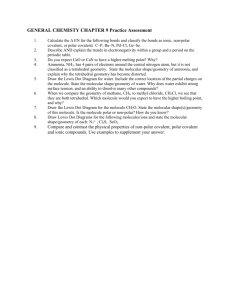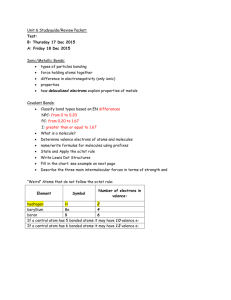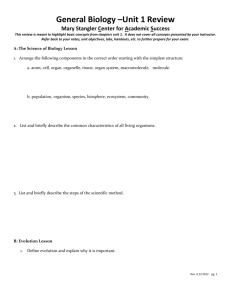How To Tell if a Molecule Is Polar or Non-Polar?
advertisement

How To Tell if a Molecule Is Polar or Non-Polar? Step 1: Draw the Lewis structure. Note the number of electron regions around the central atom, and of these which are bonding or lone pairs (non-bonding pairs) Step 2: Use this info to determine the 3D geometry of the molecule. You do this by remembering "VSEPR". Valence Shell Electron Pair Repulsion theory; around the central atom all regions of electrons repel each other to get as far away from each other as possible while pivoting around the central atom. Note that double bonds and triple bonds count as a single region of electrons. Step 3: Determine if the molecular is polar or non-polar - a molecule is (i) non-polar if the charge distribution is symmetric and (ii) polar if the charge distribution is asymmetric (not symmetric). This is where we look at dipoles (polar vs. nonpolar) for individual pairs of bonding electrons. The Decision Process: After you draw the molecule in 3D representation using VSEPR rules, if the molecule has symmetry around the central atom, the bond dipole moments will "cancel out" (like pulling in opposite directions) and the molecule will therefore be non-polar. However, if the molecule is asymmetric, the bond dipole moments won't "cancel out" and the molecule will have a net dipole moment and the molecule is therefore polar. To really understand how to do this, the Lewis structure is only the first step. You need to consider the molecule in 3D (three dimensions). You may make the following molecules using your molecular modeling kits to accomplish this. Note: molecules with two atoms are not shown in these examples; they are always linear. For two atom molecules, if the atoms are the same, the molecule is non-polar molecule; if the atoms are different, the molecule is polar. What good is this? The polarity of a molecule will tell you a lot about its solubility, boiling point, etc. when you compare it to other similar molecules. Water, for example, is a very light molecule (lighter than oxygen gas or nitrogen gas) and you might expect it would be a gas based on its molecular weight, however the polarity of water makes the molecules "stick together" very well. And it's a good thing, because if water was not so polar, we would certainly not be here. For each of the following: 1. 2. 3. 4. Draw the molecule in 3D and name the shape. Calculate the ΔEN(s) Determine if there are any dipoles present. Determine (if there are dipoles) if the charge is evenly or unevenly distributed, and therefore whether the molecule is overall nonpolar or polar. Click on the molecule's name to see the answer, but first try to do it yourself! (Note: Trigonal pyramidal is listed as tetrahedral. This is because it really is just a variation on the tetrahedral shape, and so is sometimes referred to as such. I expect you to differential between trigonal pyramidal and tetrahedral.) 1. AlCl3 - Aluminum Trichloride 2. CS2 - Carbon Disulfide 3. BeI2 - Beryllium Diiodide 4. NOCl - Nitrosyl Chloride 5. PO(OH)3 - Phosphoric Acid 6. SO2Cl2 - Sulfuryl Chloride 7. NOCl - Nitrosyl Bromide 8. BCl3 - Boron Trichloride 9. SiH4 - Silicon Tetrahydride 10. BeBr2 - Beryllium Dibromide 11. CH2O - Formaldehyde 12. NH2Cl - Chloramine 13. CH4 - Methane 14. SO2 - Sulfur Dioxide 15. AlF3 - Aluminum Trifluoride 16. NH3 - Ammonia 17. SeH2 - Hydrogen Selenide 18. H2O - Water 19. CO2 - Carbon Dioxide 20. SCl2 - Sulfur Dichloride 21. NO2F - Nitryl Fluoride 22. CSe2 - Carbon Diselenide 23. CCl4 - Carbon Tetrachloride 24. AlBr3 - Aluminum Tribromide 25. BeCl2 - Beryllium Dichloride 26. SO3 - Sulfur Trioxide 27. PCl3 - Phosphorus Trichloride 28. BeF2 - Beryllium Difluoride 29. BF3 - Boron Trifluoride (Source: http://www.tutorhomework.com/Chemistry_Help/Molecular_Geometry/Polar_Or_Nonpolar.html#problems )








